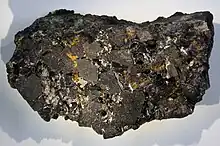呕吐石
呕吐石(英語:),曾被称为臭萤石[1] ,是一种放射性萤石,最早于1841年在巴伐利亚Wölsendorf发现[2],并在1862年命名。[3]

来自德国南部上普法尔茨市沃尔森多夫的萤石(呕吐石)
它的特点是存在多种含氟的包裹體。[4]当晶体被破碎时,氟会释放出来。据推测,铀包裹体产生的β粒子会不断将氟化钙分解成钙和氟原子。氟原子结合产生二氟阴离子,并在缺陷处失去多余电子后形成氟。[5][6]氟随后与大气中的氧气和水蒸汽反应,产生臭氧(其特征气味,最初误认为是称为的假想物质,也是矿物名称的由來)和氟化氢。
参考資料
- Carbonatites and alkalic rocks of the Arkansas River area, Fremont County, Colorado. 2. Fetid gas from carbonatite and related rocks (页面存档备份,存于), American Mineralogist, vol. 50, November–December 1965; E. Wm. Heinrich and Raymond J. Anderson
- Some physical properties of naturally irradiated fluorite (页面存档备份,存于), American Mineralogist, Robert Berman, 1956; "The material has been given the name antozonite, after the supposed evanescent gas, antozone. Earlier names were Stinkstein and Stinkfluss (Hausmann, 1847)"
- American Journal of Science (页面存档备份,存于), 1862
- Study of the solid and gaseous inclusions in the fluorites from Wölsendorf (Bavaria, F.R. of Germany) and Margnac (Haute Vienne, France) by microprobe and mass spectrometry, by R. Vochten, E. Esmans and W. Vermeirsch, Chemical Geology, volume 20, 1977 doi:10.1016/0009-2541(77)90047-X
- First Direct Evidence that Elemental Fluorine Occurs in Nature (页面存档备份,存于), News Release, Technische Universität München, 5 July 2012
- Fluorine Finally Found in Nature (页面存档备份,存于), Chemistry World, Royal Society of Chemistry, 11 July, 2012
外部链接
- Mindat.org上的Antozonite (页面存档备份,存于) 。
This article is issued from Wikipedia. The text is licensed under Creative Commons - Attribution - Sharealike. Additional terms may apply for the media files.